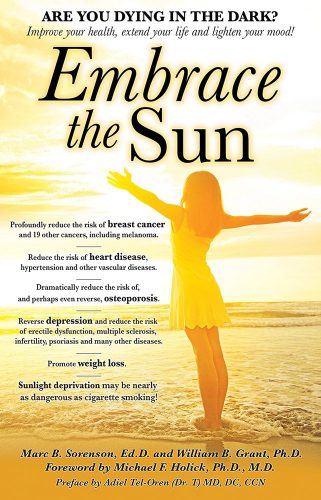Marc Sorenson, EdD, Author of Embrace the Sun
Lymph cancers and sun exposure:

Research published in the journal Blood, demonstrated remarkable risk reduction (due to sun exposure), of cancers known as lymphoid malignancies. These are cancers of the lymph system or lymph cancers. And, they include non-Hodgkin’s Lymphoma, multiple myeloma and classical Hodgkin’s Lymphoma. All of them can be deadly. This is vital information, and I have previously written about the effect of sunlight and its protective effect on children’s’ lymph cancers. http://sunlightinstitute.org/sunlight-helps-children-to-reduce-the-risk-of-non-hodgkin-lymphoma/
First of all, the researchers measured exposure to the sun among residents in different geographic areas. Then they compared the different categories of exposures to the risk of contracting these cancers.
What were the results regarding sun exposure and lymph cancers?
As a result, it was shown that those residents living in the areas with the highest quartile (fourth) of sun exposure were impressively protected against lymph cancers. That is, when compared with those in the lowest quartile. So the overall reduction in risk was 43% reduced risk of Non-Hodgkin’s lymphoma. In addition, they had a 64% decrease in the risk of one of its subcategories, known as diffuse large B-cell lymphoma. Furthermore, the risk of another subcategory of lymph cancers, chronic lymphocytic leukemia, was reduced by 54%. Multiple myeloma was also associated with a reduced risk of 43% among those in the highest quartile of sun exposure.
Especially relevant was the fact that dietary vitamin D was not associated with the risk of lymph cancers.
The researchers stated, “These results support a protective effect of routine residential [sun exposure] against lymphomagenesis [lymph cancer production] through mechanisms possibly independent of vitamin D.”
What is the salient finding of this lymph cancer research and other sunlight/vitamin D/cancer research?
Most noteworthy, in perusing the research of sunlight and disease, I noted that vitamin D was effective for some diseases. Yet, I also noted it was only minimally effective, or ineffective, for others like lymph cancer. Also, it became obvious that exposure to the sun or other sources (sunlamps) was usually profoundly effective.
So should sunlight research on lymph cancer and other cancers focus on vitamin D?
So rather than focus on vitamin D as the only photoproduct of sun exposure, the authors should have examined the big picture. In other words, the holistic sun. Thus, many of these studies should have mentioned the effect of sun exposure on vasodilation, mediated by the skin’s production of nitric oxide. Also, they could have discussed the influence of sun exposure on the production of beneficial serotonin, dopamine, BDNF and endorphin. Vitamin D is an exceptionally important photoproduct of sun exposure, but it is not the only photoproduct. Thus, I predict that a new field of research, regarding other photoproducts of sun exposure, will soon emerge. And, it will provide impressive new knowledge regarding the life-and-health-giving benefits of our most precious friend, the sun.
The takeaway for sunlight and lymph cancer:

In conclusion, these findings are doubly important. They indicate sun exposure has protective effects against lymph cancers independent of vitamin D. This is also true of other cancers we have discussed or will discuss in other blogs. It is probably also true that vitamin D produced through sun exposure is superior to that obtained through food or supplements. Thus, it appears that “Mother Nature knows best.” It seems like the sun’s rays, one of God’s greatest gifts, should not be ignored as powerful therapeutic and preventive therapy.
Read this book:

For more information on the influence of sunlight on lymph cancer, and other destructive diseases, read the book Embrace the Sun, by Sorenson and Grant.
https://www.amazon.com/Embrace-Sun-Marc-B-Sorenson/dp/069207600X
Happy sunning, and do not burn.
Marc Sorenson.
By Marc Sorenson, EdD. Sunlight Institute…
A 2016 paper in the British Journal of Dermatology showed that NMSC (also known as common skin cancer) had a positive association with cancers such as breast cancer, lung cancer and lymphoma.[1] Since NMSC is also associated with increased sun exposure, one might be inclined to say that these cancers are caused by such exposure. This is troubling, as many research papers have showed a reduced risk of most internal cancer with greater sun exposure. For example, breast cancer was the second type of cancer for which an inverse correlation between mortality rates and sun exposure was identified in the United States.[2] And, when assessing sun-exposure habits in a study of 5,000 women, scientists determined that those who lived in the sunniest areas, and who also had the highest sun exposure, had a 33% reduction in breast cancer rates compared to those who had the least exposure.[3] A subsequent study by the same group found “that a high sun exposure index was associated with reduced risk of advanced breast cancer among women with light skin pigmentation.”[4] The reduced risk was 47%. Numerous additional studies have demonstrated a reduction of the risk breast cancer among women who are regularly exposed to the sun. A discussion or these studies will me available in the book, Embrace the Sun, which should be available before the end of the 2016.
As for lung cancer, a geographical study in China demonstrated that lung cancer mortality showed a strong inverse correlation of risk with sun exposure, with an estimated 12% fall per each 10 milliwatts per meter squared per nanometer (a measurement of sun intensity) increase in UVB irradiance (sun exposure) even if adjusted for smoking.[5]
Now let’s consider lymphoma. The most recent research shows that there is an inverse correlation between Hodgkin lymphoma (HL) and the highest vs. lowest lifetime, childhood and adulthood factors: sun exposure, sun-lamp exposure, and sunburn. [1] The pooled analysis showed an odds ratio of .56, or in other words, a 44% reduced risk of contracting the disease.[6] Two items particularly stand out in this research: (1) Sun-lamp use correlated to a reduced risk of the disease—a positive result for the much maligned tanning industry—and (2) sunburn also correlated to a reduced risk. Of course, no one would recommend sun-burning—it simply serves a surrogate measurement for a high degree of sun exposure. Sun exposure can easily be used in high quantities—without burning—by moving out of the sun when the skin begins to redden, and then coming back later, after the skin has adjusted and started to tan.
Therefore, there is an interesting dichotomy between the idea that sun exposure may contribute to the three mentioned cancers, and the fact that all of these cancers have been shown to associate with low sun exposure, and be protected against by higher sun exposure.
So what is the answer? Dr. Bill Grant has found it. When people contract NMSC, they are advised to avoid the sun, thus setting themselves up for increased cancer risk.[7] Thanks again to Dr. Grant for his immediate solution to this dilemma.
There is more than sufficient research to show conclusively that most major cancers are prevented by plenty of sun exposure. Don’t be misled. Be sure to obtain some safe sun exposure whenever possible.
[1] Ransohoff KJ, Stefanick ML, Li S, et al. Association of non-melanoma skin cancer with second non-cutaneous malignancy in the Women’s Health Initiative. Br J Dermatol. 2016 May 26. [Epub ahead of print]
[2] Garland FC, Garland CF, Gorham ED, Young JF. Geographic variation in breast cancer mortality in the United States: a hypothesis involving exposure to solar radiation. Prev Med. 1990 Nov;19(6):614-22.
[3] John EM, Schwartz GG, Dreon DM, Koo J. Vitamin D and breast cancer risk: The HANES 1 epidemiologic follow-up study, 1971-1975 to 1992. Cancer Epidemiology Biomarkers and Prevention 1999;8:399-406.
[4] John EM, Schwartz GG, Koo J, Wang W, Ingles SA. Sun exposure, vitamin D receptor gene polymorphisms, and breast cancer risk in a multiethnic population. Am J Epidemiol. 2007 Dec 15;166(12):1409-19.
[5] Chen W, Clements M, Rahman B, Zhang S, Qiao Y, Armstrong BK. Relationship between cancer mortality/incidence and ambient ultraviolet B irradiance in China. Cancer Causes Control. 2010 Oct;21(10):1701-9.
[6] Monnereau A, Glaser SL, Schupp CW, Ekström Smedby K, de Sanjosé S, Kane E, Melbye M, Forétova L, Maynadié M, Staines A, Becker N, Nieters et al. Exposure to UV radiation and risk of Hodgkin lymphoma: a pooled analysis. Blood 2013;122(20):3492-9.
[7] Grant WB. Increased risk of non-cutaneous malignancy after diagnosis of non-melanoma skin cancer may be due to sun avoidance. Br J Dermatol. 2016 Jul 15. [Epub ahead of print].

